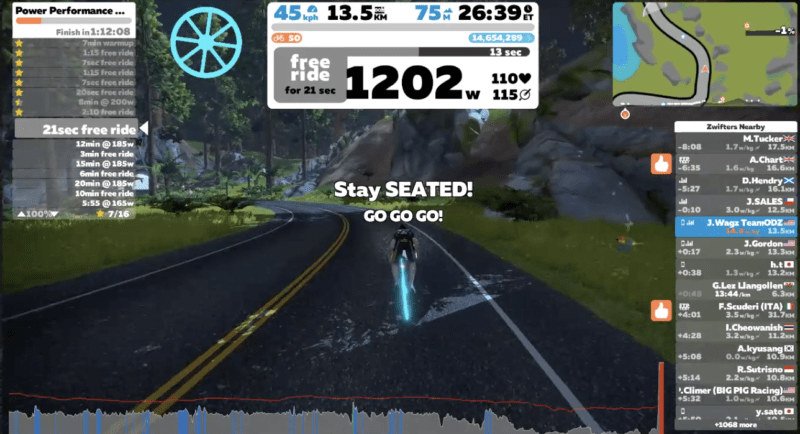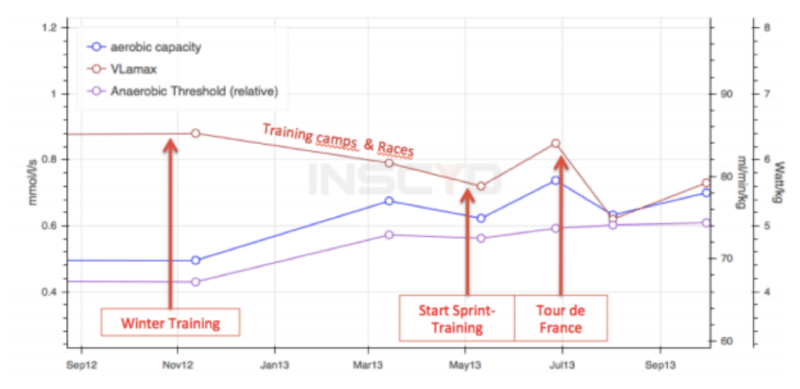
The first week of RocketBike Camp is dedicated to covering your test results. As we covered in the first installment of this series, there are four specific intervals that are part of the INSCYD testing process.
The shortest one is 25 seconds long and is designed to generate a measurement of you maximum glycolytic power.
In other words, VLaMax is the maximum power you can generate anaerobically (without oxygen). This number joins the other test metrics of Functional Threshold Power and VO2max to form a complete triad representing your fitness.
VLamax → V = flow rate | La = Lactate | Max = Maximum
VLaMax…
- …is a measure of how fast an athlete can generate power and lactate.
- …captures how your body is predisposed to “work” — aerobically or anaerobically.
- …changes over a season based on your training focus.

Example of the INSCYD VLaMax Graphic
VLaMax Markers by Athlete Type
| VLamax: | .3 or Lower | .4 to .5 | .6 to .7 | .8 or Higher |
| Athlete Type: | IM Triathlete, XC Skier | HIM Triathlete, Cycling All Rounder | Amateur cyclist (CAT 2 to 3) | Elite level cyclist, sprinter, swimmer. |
How Do We Use VLaMax in RocketBike Camp?
While most cyclists have a solid approximation of their FTP number, their VO2 is always a point of interest. But honestly, with VLaMax in the mix, VO2 is almost a vanity metric.
Your VLamax number helps us understand your physiological disposition. Admittedly, it is also influenced by your current training focus. Since VLaMax is malleable, is will vary depending on your sport of choice or your Key Race of the season.

Key Metrics Across an Elite Cycling Season
In the case of the elite cyclist above, you can see how the VLaMax starts out super high. Across the season, this Sprinter needs to reduce VLaMax max in order to be efficient enough to “hang” with the peloton across the longer events, and eventually stage races. The final peak into the Tour de France brings together the aerobic capacity with the elite level sprinting ability. A textbook build captured in data!
VLaMax In Sprinters
Sprinters want a high VLaMax to maximize high power in short durations. A high VLamax allows for high bursts of short duration power.
But there’s a catch — it also reduces endurance capacity.
Sprinters can use carbs better for these intense intervals and even ride above measured FTP by 10% as needed. But this competitive advantage doesn’t translate beyond shorter windows.
VLaMax in Endurance Athletes
Endurance athletes, on the other hand, benefit from a lower VLaMax. A low VLamax allows for higher anaerobic threshold (FTP), higher fat combustion and better carbohydrate sparing.
An athlete with a lower VLaMax will produce lower short duration power, but the upside is even in these efforts they produce less lactate than their “sprinter” friends.
For endurance events such as an Ironman, or a Marathon for example, a low VLamax is desirable.
VLaMax in the All Rounder
There is a case for “middle” VLamax. This would be the bike racer who is an all-rounder. Possibly a mountain biker…or an aggressive 70.3 triathlete…or a Gravel racer.
The All-Rounder possesses just enough work capacity for a challenging 3 to 5 hour session with both high and low efforts.
Despite not having breakaway strength, this athlete can surge and cover as needed. And keep the pressure on.
With the right timing (and course), being an All Rounder could be just what’s needed for a breakthrough performance.
Next Installment = Peak Recovery
But focusing on these numbers alone will be a big mistake. Test data gives us actually a great deal more information on exactly how the athlete generates their power. This information allows us to diet even more deeply into how these athletes function and where opportunities exist for improvement.
Stay tuned for another installment to learn more about how INSCYD powers RocketBike Camp!


Leave a Reply